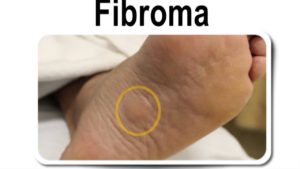Plantar Fibroma (fibromatosis) occurs with an excessive accumulation of collagen fibres through the plantar fascia. This is a long band of tissue that lies in the bottom of your foot and connects the ball of your foot (the metatarsal heads) to the heel (the calcaneus bone).
How Does It Develop?
It is uncertain as to whether the plantar fibromas form due to an abnormal response in healing a microtear through the plantar fascia, or whether it is strictly a condition of abnormal collagen development. They are believed to be more likely to occur after trauma or injury to the plantar fascia, in patients with a predisposition to other connective tissue disorders. Plantar fibromas are more common in men than women. They are more likely to appear at in middle aged or elderly patients, although they can appear at all ages.

What To Look Out For?
- Typically, the condition can be asymptomatic with no major concerns or symptoms.
- A visible bulge in the central or medial plantar area of the foot.
- There can be pain after long bouts of walking, standing – especially when the nodules begin to affect soft tissue under the foot.
- Can be painful to touch due to their location; they are susceptible to experiencing pressure from footwear or the ground when weight-bearing.
How to manage your condition?
- Plantar fibromas themselves are benign; i.e. non-cancerous and can present asymptomatic. In early stages observation is key to manage if it begins to progress
Conservative management is recommended in the early stages of the condition.
- The use of padding in shoes.
- Non-steroidal anti-inflammatory medication.
- Orthotic/insole prescription.
- Appropriate footwear prescription.
- Physiotherapy (joint mobilisations, exercise prescription, soft tissue release).
- Stretching.
In severe cases, further invasive management may be appropriate.
- Local corticosteroid injection to the affected area.
- Surgical intervention can be indicated – the removal or partial removal of the plantar aponeurosis. Aim of surgery is to release tension.
- Complications to surgery can present, and long term research suggests partial removal results in re-occurrence of the condition.
- There is a more favourable prognosis with complete radical excision of the plantar aponeurosis.
- Note: Surgery should be considered only when conservative measures have failed and the tumour has progressed from its early stages.
If you are experiencing a bulge or pain in the foot. Our qualified Physiotherapist at Pivotal Motion can help. Book an appointment online or call us on 07 3352 5116.
